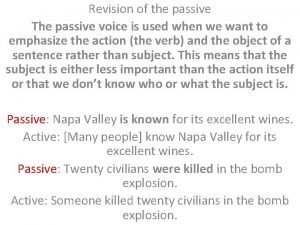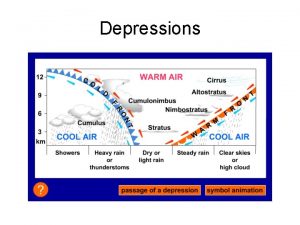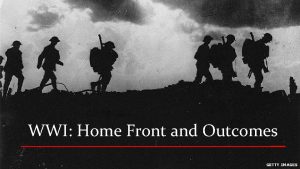The Home Front and Civilians CHAPTER 17 LESSON


















- Slides: 18

The Home Front and Civilians CHAPTER 17 LESSON 3

Starter (write down definition) �Mobilization: the process of assembling troops and supplies and making them ready for war.

Quiz � 1) What event forced the U. S. to enter the war on the side of the Allies? � 2) The Allies consisted of what three countries? � 3) The Axis powers consisted of what three countries?

Starter

Objective �Students will be able to understand how civilians on the home front were affected by the war through mobilization.

Intro �World War II was a total war in which fighting covered most of the world. Economic mobilization was extensive, and the war had an enormous impact on civilian life. �Number of civilians killed in WWII was almost 20 million, much higher than WWI.

Group Work (10 min)

Answers �Soviet Union: shortage of food and housing; women entered the workforce and military �United States: widespread movement of people looking for jobs; Japanese Americans removed to camps; women entered workforce. �Japan: imported labors from China and Korea. �Germany: total mobilization (by 1944, the entire economy was geared toward the war effort)

Question �**What kinds of social turmoil resulted from the war effort in the United States?

Answer �Workers in boomtowns faced a shortage of houses and schools. African Americans faced racial tensions. Japanese Americans were often imprisoned in camps and required to take loyalty oaths.

Rosie the Riveter Activity

African American Migration • More than 1 million African Americans moved to a different part of the United States in search of industrial jobs. • They left the rural South for cities in the North and the West. • The presence of African Americans in areas where they had not lived before led to racial tensions and sometimes even racial riots.


Internment Camps Fearing a Japanese invasion following the attack on Pearl Harbor, the U. S. government established the U. S. War Relocation Authority to organize the removal of people of Japanese ancestry from their homes on the West Coast. Some 110, 000 people were moved to isolated relocation centers in California, Arizona, Idaho, Utah, Wyoming, and Arkansas. Housed in military barracks, adults were given few opportunities and children were given little education. In 1988, the government apologized for the internments and passed legislation providing payments to the surviving victims.

Internment Camp

Internment Camp

DBQ �“When I look out at a group of Americans of German or Italian descent, I can tell whether they’re loyal or not. I can tell how they think and even perhaps what they are thinking. But it is impossible for me to do this with inscrutable (mysterious) Orientals, and particularly the Japanese” �Based on this quote, how do you think some Americans felt about Japanese-Americans? Do you believe that the internment (imprisonment) of certain groups is ever justified during wartime?

Mobilization Summary Women entered the workforce in increasing numbers, though Japanese women remained in traditional jobs, and German women resisted factory work; African Americans found economic opportunity but suffered from racial tension, and Japanese Americans were often imprisoned in camps and forced to sign loyalty oaths.
 Assembling troops and supplies for war
Assembling troops and supplies for war Passive voice of i want someone to love me
Passive voice of i want someone to love me Warm front sketch
Warm front sketch Dead front vs live front transformer
Dead front vs live front transformer Front cover page for school magazine
Front cover page for school magazine Tuskegee airmen apush
Tuskegee airmen apush Perbedaan home care dan home service
Perbedaan home care dan home service Perbedaan home care dan home visit
Perbedaan home care dan home visit Mobile home parks for sale in sc
Mobile home parks for sale in sc Unit 3 home sweet home
Unit 3 home sweet home Come home come home jesus is calling
Come home come home jesus is calling Oak springs rv park
Oak springs rv park Let's go to your house
Let's go to your house Arman home sweet home
Arman home sweet home She said that, home economics stands for the ideal home.
She said that, home economics stands for the ideal home. Home sweet home survive
Home sweet home survive Chapter 1 lesson 1 your total health lesson 1 quiz answers
Chapter 1 lesson 1 your total health lesson 1 quiz answers Hát kết hợp bộ gõ cơ thể
Hát kết hợp bộ gõ cơ thể Frameset trong html5
Frameset trong html5



































